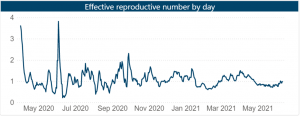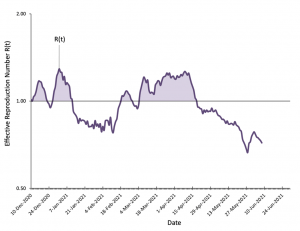Free rapid COVID-19 testing kits are now available to businesses
Visit gncc.ca/workplace-self-screening-kits to learn more and reserve kits for your organization.
Niagara Public Health offers clarification on Section 22 orders
Niagara Public Health has, in conversation with the GNCC, offered an outline of indicators that it may be safe to lift current Section 22 orders on retailers and on food and beverage service businesses. Public health is currently monitoring two primary indicators: the number of cases per 100,000 people, and the reproductive number (both are tracked in the Niagara COVID status updates at the end of every GNCC Daily Update).
Ideally, Public Health is looking for a sustained caseload of 15 per 100,000 or fewer, and to be at least consistently below 25. For the past ten days, Niagara has trended between 35 and 40. The typical number in the summer of 2020 was 5. Figures on June 8 indicated Niagara was still substantially above the provincial average and even markedly above Toronto. Niagara fell behind Peel and Hamilton, both of which have also enacted strong Section 22 orders on local businesses.
Public Health is also monitoring the reproductive number (Rt), which is the number of new cases each infection creates (e.g. if each infected person goes on to infect two other people, the Rt is 2). While Niagara had briefly dipped down to 0.8, it has gone back up to about 1.0. This number would have to hold at significantly less than 1.0 or, preferably, continue to fall, indicating that the rate of infection is slowing, before lifting the orders. The provincial average is currently at about 0.7 and has been falling.
The GNCC urges all Niagara residents and organizations to comply with all public health measures and advice, and asks that everyone eligible for a COVID-19 vaccine should get one as soon as possible.
Ontario accelerates second doses of AstraZeneca COVID-19 vaccine
The Ontario government is further accelerating the second dose interval for individuals who received their first dose of an AstraZeneca COVID-19 vaccine to eight weeks. Individuals who received their first dose of the AstraZeneca vaccine are eligible to book their second dose appointment at an interval of eight weeks or more with informed consent.
Individuals can choose between a second dose of AstraZeneca or an mRNA vaccine, at an eight to 12-week interval, recognizing that while waiting 12 weeks helps to ultimately provide more protection, some may choose to receive their second dose sooner to have the increased protection provided by a second dose earlier.
Ontario releases plan for professional and elite-level sport reopening
The Ontario government is releasing a framework for select Ontario professional and elite-amateur sport leagues and events that outlines the minimum requirements that must be met for a safe return to play.
A small number of professional and elite-amateur sport leagues and events will be able to return to play under stringent public health and safety protocols. This is in advance of the broader return to play for amateur and recreational sport that will be enabled through the Roadmap to Reopen, which will allow sport and recreation to resume in incremental steps throughout summer.
WanderLost Lincoln helps kick-start tourism recovery
In early spring, the Town of Lincoln received $83,920 in funding to help launch a new WanderLost Lincoln event concept from the Government of Ontario, through the Ministry of Heritage, Sport, Tourism and Culture Industries’ Reconnect Festival and Event Program. With the Province’s extended Stay at Home Order coming into effect in April, the Town delayed the launch of WanderLost and focused on activating online tactics such as Mother’s Day and Father’s Day gifting to keep the destination top of mind.
With the Province safely moving into Phase One of its Reopening Framework, the Town of Lincoln can now fully activate this program and begin to realize the program’s potential to create a greater awareness of Lincoln as a tourism destination in its own right, as well as create qualified, revenue generation opportunities for local tourism business partners.
For more information on how to participate, please contact Paul Di Ianni, Director, Economic Development and Communications
at 905-563-2799 ext. 272 or PDiIanni@lincoln.ca.
Lower sales in petroleum, coal, and transportation equipment lead to manufacturing sales decline in April 2021
Manufacturing sales fell 2.1% to $57.1 billion in April, on lower sales in 11 of 21 industries. Much of the decline was attributable to lower sales of transportation equipment and petroleum and coal products.
The machinery industry posted the largest sales gain, followed by the wood product and chemical industries.
Manufacturing sales excluding the transportation equipment industry increased 1.5% in April, the 12th consecutive monthly gain.
Although the Canadian auto industry has been affected by the global shortage of semiconductor chips since January, the impact worsened in April as every major auto manufacturer had to halt or ramp down production. Motor vehicle sales were down by over one-third (-36.5%) to $2.3 billion in April, the largest month-over-month decrease since April 2020. In the motor vehicle parts industry, sales fell 19.0% to $1.9 billion, the lowest level since May 2020. The semiconductor chip supply shortage is expected to continue throughout the second quarter. Exports of motor vehicles and parts decreased 18.1% in April.
Wood product sales rose 6.5% to a record-high $4.9 billion in April, mainly on higher prices. Sawmills and wood preservation manufacturing accounted for most of the gain.
In Ontario, sales fell 5.5% to $23.9 billion in April, the lowest level since June 2020. Following a sales increase in March, many auto and auto part assembly plants had to ramp down production again in April because of the semiconductor chip shortage, resulting in lower sales of motor vehicles (-37.7%) and motor vehicle parts (-19.6%).
Reading Recommendations
Factbox: What are G7 countries pledging on vaccine doses?
Reuters
Reuters has reported that Canada is in talks to donate excess doses through COVAX, although it has not yet made public any firm commitment of donations, or said how much it plans to donate. U.S. President Joe Biden plans to buy and donate 500 million doses of the Pfizer Inc (PFE.N) coronavirus vaccine to more than 90 countries. He has also called on the world’s democracies to do their part to help end the pandemic.
British Prime Minister Boris Johnson said that “the G7 will pledge to distribute vaccines to inoculate the world by the end of next year, with millions coming from surplus UK stocks.” Britain says that G7 leaders are expected to agree to provide 1 billion doses via dose sharing and financing to end the pandemic in 2022.
How the Canadian economy can continue to benefit from U.S. battle with China
CBC News
When Jerome Powell, the world’s most powerful central banker, meets with the media this Wednesday, nobody expects him to say the soaring inflation we’re seeing has forced him to hike interest rates.
Despite data out last week showing year on year inflation has shot up to levels unseen for 13 years, most economists expect the U.S. Federal Reserve is not yet ready to end the stimulus low rates offer to an economy that has once again become an engine of North American and global growth.
Some worry Canada will be left out of the hot U.S. economic revivial, due to the U.S. Buy America strategy, but a series of developments last week offer evidence that this country can continue to profit by supplying the needs of its bigger neighbour.
Niagara COVID Stats Tracker (June 5)
| December 18 | December 25 | January 1 | January 8 | January 15 | January 22 | January 29 | |
|---|---|---|---|---|---|---|---|
| Reproductive number | 1.4 | 1.8 | 1.4 | 1.1 | 1.0 | 0.7 | 0.9 |
| New cases per 100,000 | 101.2 | 267.3 | 469.8 | 575.8 | 507.1 | 295.5 | 250.6 |
| New cases per day (not including outbreaks) | 60.7 | 178.7 | 311.7 | 376.9 | 325.4 | 182.7 | 145.7 |
| Percent of hospital beds occupied | 97% | 95.2% | 98.2% | 103.2% | 104.5% | 103.6% | 106% |
| Percent of intensive care beds occupied | 78.8% | 77.3% | 87.9% | 87.9% | 90.9% | 89.4% | 93.9% |
| Percentage of positive tests | 6.1% | 15.6% | 28.1% | 28.6% | 26.6% | 21.2% | 16.2% |
These data show the status of the COVID-19 pandemic in Niagara. The Province of Ontario is now using a provincewide approach to reopening, and these data no longer have any influence on Niagara’s restrictions.
Data are drawn from Niagara Region Public Health.
Guide
Reproductive number: the average number of new cases each case causes. If each person infects one other person, the rate is 1; if each person infects two people, the rate is 2. Under the outdated COVID-19 response framework, the target for “green-prevent” was less than 1. Niagara Public Health has indicated that this number should be consistently below 1 for Section 22 orders to be lifted.
New cases per 100,000: the total number of new cases per week identified per 100,000 population. Under the outdated COVID-19 response framework, the target for “green-prevent” was less than 10. Niagara Public Health has indicated that this number should be consistently below 15 for Section 22 orders to be lifted.
New cases per day: the total number of new cases identified per day over seven days using a rolling average. This number does not include identified outbreaks.
Percent of hospital beds occupied: the total percentage of the Niagara Health System’s hospital beds currently in use. The average occupancy rate of both acute care beds and total hospital beds in Ontario was 96 per cent in 2018-19. It should be noted that this rate was the highest (worst) in the Organisation for Economic Co-operation and Development (OECD).
Percent of intensive care beds occupied: the total percentage of the Niagara Health System’s intensive care hospital beds currently in use. The average occupancy rate of both acute care beds and total hospital beds in Ontario was 96 per cent in 2018-19. It should be noted that this rate was the highest (worst) in the Organisation for Economic Co-operation and Development (OECD).
Percentage of positive tests: the percentage of COVID-19 tests that were positive. Under the outdated COVID-19 response framework, the target for “green-prevent” was less than 0.5%.
Niagara COVID vaccination tracker (June 14)
Niagara’s most up-to-date vaccination numbers are presented below, along with comparison data from Ontario, Canada, and G7 countries.
Total doses administered in Niagara: 354,807
Total doses administered in Niagara since yesterday: 2,939
Step Two of the Roadmap to Reopen will begin when Ontario has vaccinated 70% of adults with one dose, 20% of adults with two doses, has positive public health indicators, and has been in Step One for at least 21 days.
| Percentage of population with one dose | Percentage of population fully vaccinated | |
|---|---|---|
| Niagara | 82.7% | 78.2% |
| Ontario | 84.6% | 79.1% |
| Canada | 84.7% | 78.6% |
| United States | 75% | 64% |
| United Kingdom | 78% | 72% |
| Germany | 76% | 74% |
| France | 80% | 77% |
| Italy | 83% | 76% |
| Japan | 80% | 79% |
| World | 63% | 53% |
Data are drawn from Niagara Region, the Government of Ontario, and Oxford University’s Our World in Data project.






